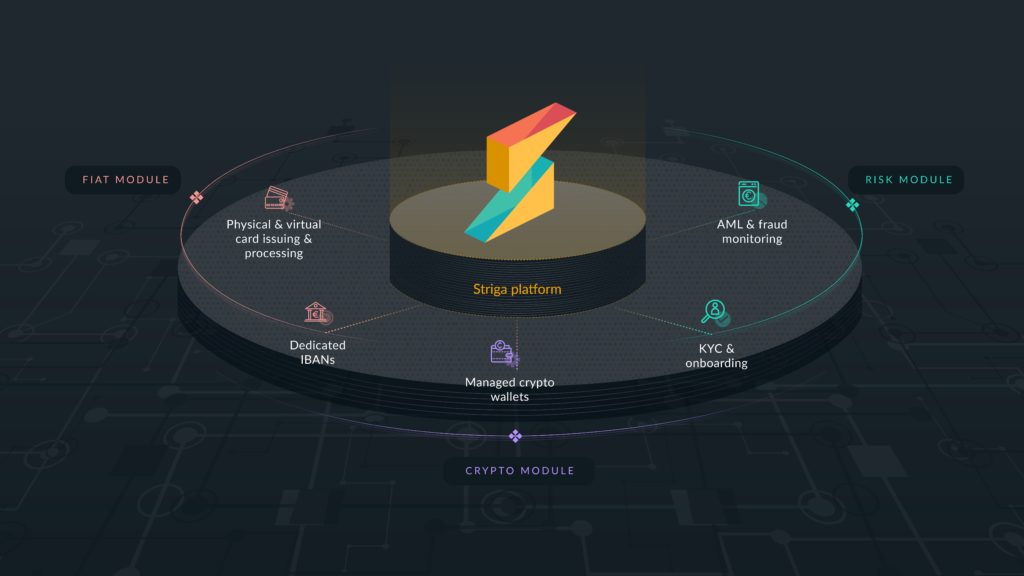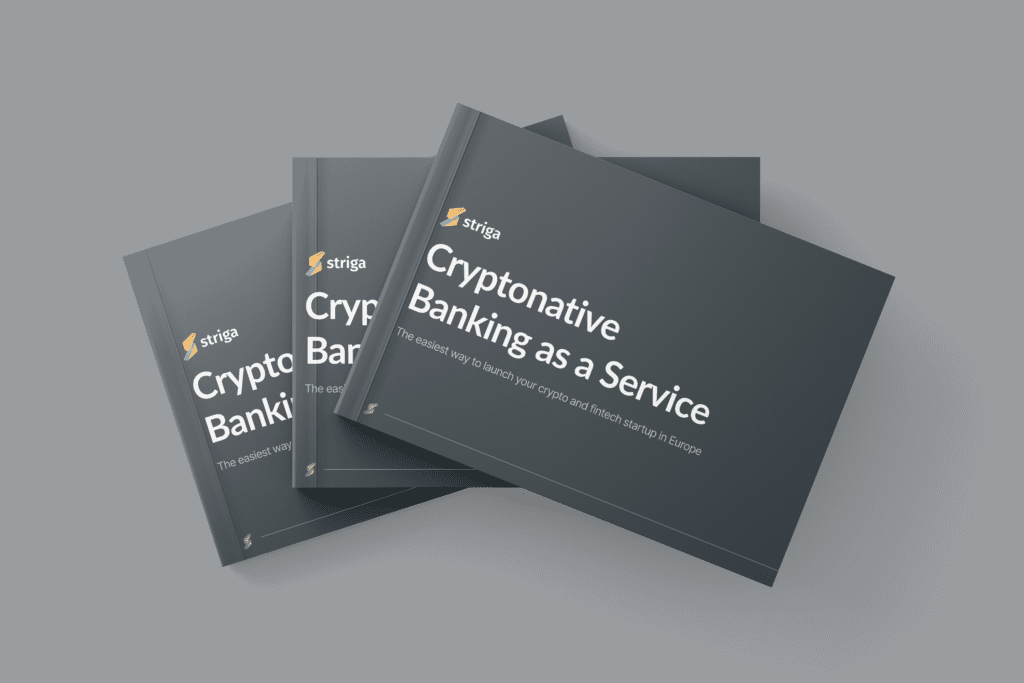How can crypto companies enhance their crypto banking services using Striga?
How can crypto companies enhance their crypto banking services using Striga?
- Mousser R.
- 8 min read

Table of Contents
The Striga platform integrates into any business seeking embedded finance, eliminating process inefficiencies, and ensuring a fast and cheap way for fintech and crypto companies in Europe to launch their products.
Card issuing, IBANs, managed crypto wallets, crypto exchanges, and compliance solutions
In Europe, regulatory frameworks for crypto licenses are expanding rapidly, and with them, clarity on admissible activities grows too. Many crypto and fintech organizations are taking this as an opportunity to ramp up their compliance efforts and get into the crypto-banking space, thus discovering new features and services to offer.
Crypto and fintech companies are discovering the potential of the crypto banking space
As interest in digital assets increases, new revenue streams will be made available. The core of these revenue streams will come from being able to offer custody and exchange of digital assets to end users. Most crypto companies are already looking to blend their current services with various traditional banking services in order to grow their product.
Challenges:
What are the challenges that crypto companies face?
Aside from standard banks and Fintechs resisting change, crypto-first companies face various challenges when trying to scale their cryptocurrency products or services. In fact, crypto exchanges and wallets face a highly strategic challenge: Getting first-time buyers to trade cryptocurrencies seamlessly, and offering them an all-in-one package: IBANs, Cards, Crypto-trading services, and a full Compliance & KYC service.
The strategic part comes from keeping their funds in your ecosystem. The moment your user needs any feature that you don’t have, they will move their funds to an app that does, and if that app has an all-in-one package, there is a chance the user will just stay there.
Limited features
Crypto companies that want to grow must provide at least the basic features that people associate with crypto ownership. These include crypto wallets, real-time trades, and, more recently, the core traditional banking services. While the crypto market has seen explosive growth in the last year, most crypto applications do not yet meet basic regulatory standards. Due to this, they can’t offer banking services powered by the crypto capabilities that users are increasingly looking for.
Security Concerns
Many potential crypto buyers are wary of starting a cryptocurrency investment simply because security risks are not fully understood.
Due to this concern, crypto companies are facing the commercial challenge of providing a secure technical infrastructure that authorizes and executes transactions safely. Additionally, crypto companies must deliver a transparent solution in order to convince users to subscribe to their products or services. Tangible security means trust, and trust is key for crypto adoption.
Compliance and KYC processes
Compliance frameworks have been historically designed to handle the risks associated with fiat currencies. As new asset classes are introduced, frameworks will need to be recalibrated to manage new risks.
Today, it is critical for crypto companies to be able to ascertain if all the parties involved in their transaction flows are compliant with regulations: AML, KYC, CTF, and the FATF’s Travel Rule. The task itself is daunting, even more so if each flow involves a different company. An emerging solution to that is crypto banking-as-a-service companies that integrate a risk management module.
Digital and Crypto banking as a software:
Crypto and Banking services under one roof: Enabling crypto banking in a software platform
The core mission of Striga is to help European crypto companies launch crypto-native financial products. The goal is for them to enable their users to conduct traditional financial transactions. This means the users will receive, within the same product platform, a new breed of digital cryptocurrency services. They will transition from a crypto company to an online crypto-banking platform
Embed banking services into your crypto services
Crypto companies can start improving their customer experience by issuing EUR denominated bank accounts in their apps and products. This also allows for instantly issuing virtual and physical debit cards to their users, and letting them spend crypto in real-time, as well as fiat currencies.
Embed payments into your crypto platform
To remain ahead of the competition in the crypto world, crypto companies need the right partner to embed payments into their crypto services. A powerful, scalable infrastructure allows crypto wallets and exchange platforms to process important volumes of fiat transactions. Striga allows you to distinguish your product with new crypto-fiat capabilities, including virtual and physical cards, giving customers more and better ways to spend their funds.
Various crypto services with large-scale investing opportunities
Striga enables innovators today to build different crypto custody models in a variety of forms. Crypto exchanges can offer digital wallets that allow their end-users to hold, protect, and transfer crypto assets. Additionally, if users start performing all their operations within a single platform, and keeping their funds there, companies can start enabling investment opportunities and go from exchange+wallet to neobank.
Robust risk and compliance program
Crypto companies that desire to engage with standard financial services will need to meet the institutions’ risk management and compliance expectations. These are driven partly by the institutions’ regulatory obligations and scrutiny guidelines.
By building your product with Striga, you can delegate that burden to an expert-reviewed module. Striga manages in-house client verification by conducting the KYC process and monitoring crypto funds for AML compliance, so that you don’t have to expend resources on it.

Use Case 1: Crypto Wallet
Cryptocurrency wallet built with a crypto-banking service platform
By using a crypto-banking service platform such as Striga, crypto wallets can act similarly to a bank, offering secure storage and transactions to their users, both in crypto and traditional currencies. Let’s break down why crypto wallets built on top of a crypto-banking service platform have such potential to be scalable.
Leverage Multicurrency Funds Storage
Crypto wallets integrated with a banking service support major cryptocurrencies and, most importantly, fiat currencies. This competitive advantage plays a critical role, as the wallet can hold all of the user’s various cryptocurrencies and fiat currencies in one place. This means that all their transactions will be done from the same application, keeping retention high.
Competitive Interest Rates
By partnering with a Crypto-native banking platform, crypto wallets connected to the DeFi system can enable their customers a staking feature. There, they can earn annual interest, or by running rewards programs, access alternative ways of earning profit.
Flexible and Secure Transfers & Instant Payments
Crypto wallets can offer instant and secure transfers, so users can purchase anything, anywhere with their crypto-fiat card. Under normal circumstances, cryptocurrency transactions take many minutes, but with Striga’s Lightning-enabled cards, it’s seconds.
Users can also transact many supported currencies, crypto and/or fiat, because the wallets provide dedicated IBAN accounts. This comes with the added bonus of all transactions being monitored and checked in real-time, so you have full certainty of their security, while keeping them flexible.
Use Case 2: Crypto Exchange
Building a regulated cryptocurrency exchange platform powered by fiat integrations
Main Challenge
Today, more and more people are trying to figure out how to turn their fiat currency, such as euros, into a digital currency like Bitcoin. This is where exchanges come in. Now, enabling people to change one crypto for another is relatively straightforward, but if you throw traditional currencies in the mix, the regulations, infrastructure and liquidity get complex fast.
Building a fiat-to-crypto exchange, though, is increasingly becoming the bare minimum to tap into the market. Exchanges now allow their customers to use traditional payment methods such as a debit card, credit card, or bank account in order to make their initial purchase of cryptocurrency. That said, once fiat goes in, pretty much all users can do is hold it or convert it to crypto. If they want to go back to fiat at some point, and use it for anything other than buying crypto again, they have to take the money out.
There’s the main challenge: even if a company managed to go from crypto-crypto to fiat-crypto, once a user needs to use their fiat money, they are out of the ecosystem.
Crypto exchanges with accounts to hold fiat balances
Striga, as a Crypto-banking platform, helps crypto companies directly connect both the exchange and a banking application for their user to explore. In other words, end-users will benefit from dedicated IBAN accounts so they can switch between crypto and fiat in a few steps, and retain the features they need from both exchanges and banks, all within your ecosystem.
Crypto on-ramp/off-ramp: diverse capabilities for better customer experience
With Striga, crypto exchanges can easily build their fiat on-ramps. In short, users will be able to deposit fiat into the system through a debit or credit card, bank transfer, or wire transfer. That’s the easy part. But the fun is in the off-ramp.
The crypto exchange can build the ideal off-ramp flow by issuing a crypto-to-fiat debit card that is directly connect to each user’s personal balance. In essence, this means they can keep their crypto for as long as they want, knowing full well they can instantly shift it to fiat when the need to purchase anything arises. This effectively means that users will never feel the need to withdraw their funds from the exchange, as it provides them with all the day-to-day features that a traditional banking app does.
What is the process of converting users' fiat money to crypto?
Once the user is verified on your trading platform, they will be able to select from their payment method options (debit card, credit card, bank transfer, or wire transfer) and deposit the money to their brand new, personal IBAN within your app. There, as it’s connected to your exchange, they can easily purchase their cryptocurrency of preference.
Closing Thoughts
Deliver a better crypto experience powered by fiat capabilities
Striga provides a new and improved class of crypto-banking service, where crypto companies can access various crypto and fiat flows all at once, under the protection of a risk module.
By adopting this all-in-one flow, it becomes easy for crypto companies to quickly accept fiat transactions and trade funds in a regulated and secure environment.
Ready to take your crypto product to the next level? Request a free consultation here.
Striga Crypto-native Banking as a Service:
Your path to building and launching financial products
Join the financial businesses that use Striga’s cloud platform to delight their users and launch their own products without the complexities that come when dealing with core banking solutions’ relationships, licensing, compliance and payments methods.
*Striga Technology OÜ is currently pursuing a Virtual Asset Service Provider License in Estonia in accordance with the recently (March 2022) introduced amendments to the Estonian law.
